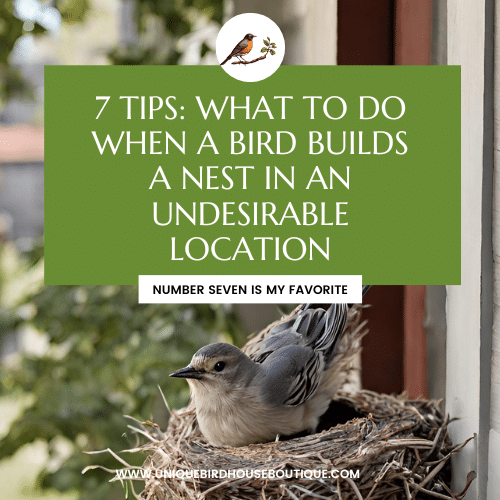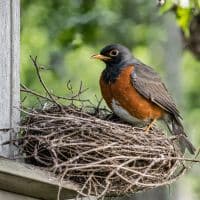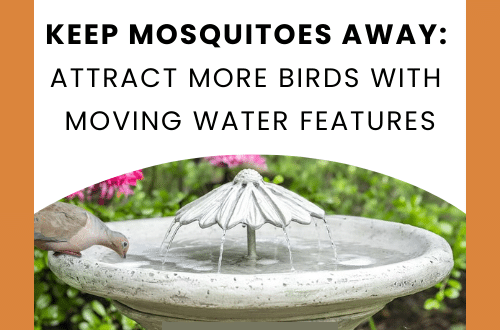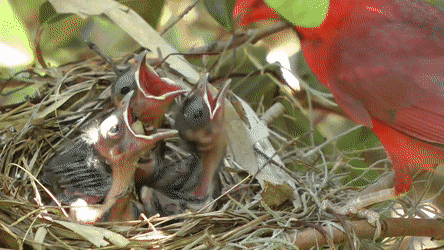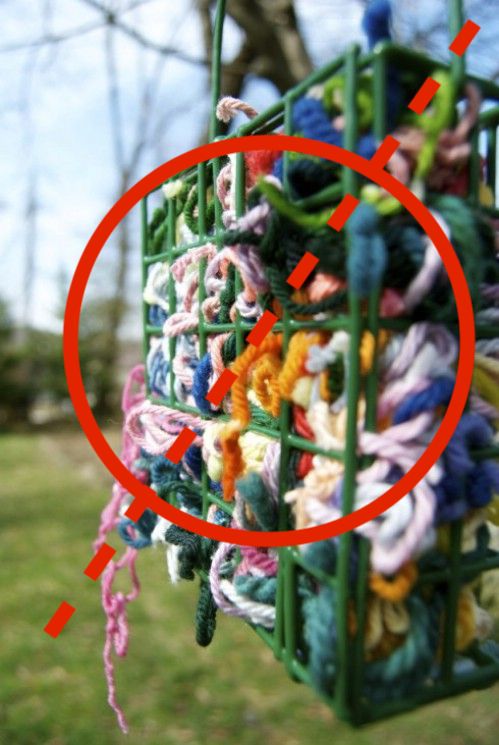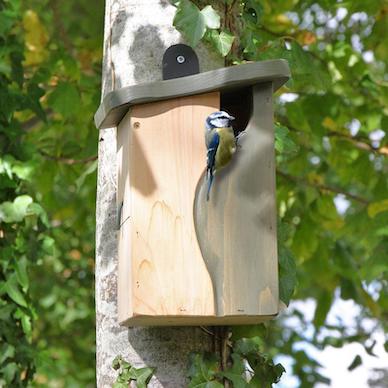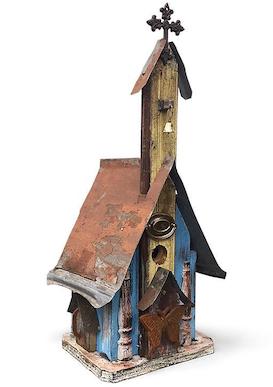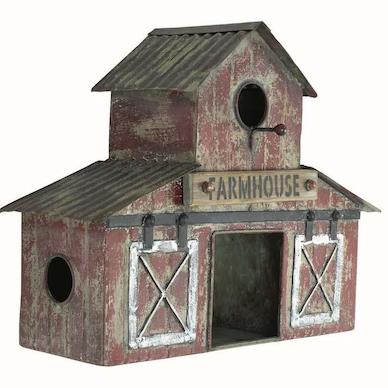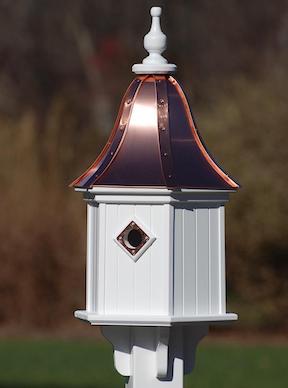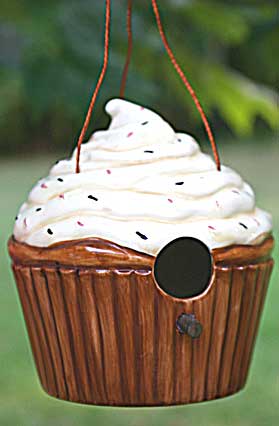-
Seven Tips: How to Handle Unwanted Bird Nests on Your House
A bird has built a nest in an undesirable spot on your house, front porch, window ledge, back door or really any inconvenient place close to your house, now what?
We’ve all been there. One morning you walk out your front door and see a bird darting back and forth, carrying twigs and grass. When you return home, there is a full-blown nest right above your front door. At first it can be quite charming, however several days pass and you are attacked by a protective mama bird, or you just generally don’t enjoy all the shall we say “droppings” left behind. Whatever the reason, there are some do’s and don’ts of managing the inconvenient nesting situation.
First, the good news. The nesting period is not forever, and some species may only be a matter of weeks. The nesting cycle for most songbirds is around 4 weeks total, from laying of the egg to chicks leaving the nest.
- IDENTIFY. First things first, start by identifying which feathered friend has taken up residence on your porch. NestWatch has a great tool for identifying the type of bird who has built the nest, so you know what you’re dealing with.
- PROTECT. Native birds’ nests are protected. Believe it or not, there is actually a law in place (Migratory Bird Treaty Act of 1918) to protect birds and their nest nationwide. If in question, we always suggest you check with your local wildlife authority. Doing this will also give you a better idea of their nesting cycle so you can keep an eye out.
- DO NOT DISTURB. Once a bird has laid eggs in the nest, you’re out of luck. Do not touch or remove the nest. Try not to use the area around the nest until the young have fledged to ensure that the parents will not abandon their nest. If this is not possible, try to minimize your presence around the nest; many yard birds are tolerant of occasional disturbances.
- REMOVE (SOMETIMES). Keep an eye out for nest activity. After the brood has fledged and moved on, its safe to remove to nest. We suggest using gloves, as bird droppings or the nest may have harmful contaminants. Most birds only nest once a year, however birds like the American Robin, Eastern Bluebirds, House Wrens, American Goldfinch and Northern Cardinals can produce several broods a year. This makes it important to identify the type of bird. For songbirds with multiple broods in a season If the nest is in a safe location and not too terribly troublesome, please leave it be if at all possible.
- PREPLAN. Start thinking ahead on how you’d like to discourage them from nesting in the same spot next year.
- Hang a Wind Chime: Birds aren’t particularly keen on the movement and sound of the wind chimes, especially if they’re made from metal or shiny materials. This will act as a natural deterrent if placed close enough to the undesired nesting spot.
- Mount a Light: Nothing disturbs my sleep quite like light and birds aren’t too different. Flashes of bright light will deter birds from nesting in a particular area as the variation between light and shadow may signal danger.
- Install Bird Spikes: This is our least favorite option and should only be used if the nesting spot is physically dangerous for future broods. These rods are dull and will not harm the birds, but there are certainly more preferred options than this.
- PROVIDE. Giving birds a suitable place to build a house is the best way to relocate a nest going forward. If you know which type of bird was in the undesired nest, you can select a birdhouse that fits that particular birds needs. If you are ever unsure, we are always more than happy to help point you in the right direction! [email protected]
- ENJOY. Nature is one of our greatest gifts. While a nest may not be in the most ideal location, savor the moment. Try to keep in mind that new feathered friends are on the way. The joy they bring far outweighs any short-term nest location inconvenience.
-
Best Birdhouses in 2020…
Come with Free Nesting Materials!
Through March we’re giving away some organic premium nest materials with all birdhouses. North American songbirds adore our nest materials… even those who may not use a birdhouse will partake! A few of those non-cavity dwellers (who prefer to nest in trees and shrubs) include; cardinals, goldfinches, house finches, blue jays, robins and others.
Although the materials are found in nature, you might just jump-start the nesting process by offering the materials and having any existing birdhouses cleaned out and repaired if necessary… before birds are scouting! Unusually warm temperatures around most of the country have birds at least looking for the perfect home already.
Because backyard birding has become so popular, you may have seen all the DIY nesting material tutorials and posts on social media. If it’s on the web, it must be true… right?
Nope! Especially if you’ve seen this image or similar with yarn strings in a suet cage.
Please avoid! The DIY part is perfect and we do encourage it – but with natural, healthy and correct materials.
Refrain from anything with dye as its not found in nature and may be harmful to hatchlings and older nestlings alike. If using raffia, strings or stringy moss (Spanish moss) be sure to cut strips short. Two to three inches is plenty as strings may become tangled in little birdie feet! Should this occur, the bird’s circulation could be in danger- possibly constricting blood flow.
Should blue jays be terrorizing your hanging baskets, they’re most likely after the coco liner or moss for nest nest construction. Best to take an extra liner and cut pieces to place on the ground or in a suet cage.
We have several older blog posts on the subject… from years ago and prior to social media hype. Examples from our own yard show how easy it is to DIY safely and correctly.
Dryer lint: Steer clear! Even though it’s so soft & fluffy, fibers may contain dye which once again, are not found in nature.
Pet hair: Definitely a yes unless fido or fluffy is on medication or they’ve been treated with flea & tick products.
Always: Let birds do the interior decorating! Place nesting materials nearby so they can gather what works best in their own birdhouse.
You can encourage residency and have nesting birds grace your place this season… whether they use birdhouses or not!
Oh yeah… a few 2020 birdhouse models that rock!
-
unique birdhouses for fantastic gifts!
Bluebirds are staking out houses in hopes of attracting a female, buds are appearing on trees, and bulbs are now sprouting. This could only mean spring is around the corner. I’m so ready for spring!
It’s been a warm few days, but likely just a teaser. The dreaded cold snap will hit again-damaging all tender vegetation. But resident wild birds are pretty well-adapted to these kinds of weather changes. Help them thrive by providing proper nesting sites, a very scarce commodity.
Unique birdhouses that are totally fun and functional, with ventilation, drainage and clean-outs help provide these critical nest sites birds so desperately need. Competition for bird houses from non-native species has taken it’s toll on our own cavity-dwelling birds. European Starlings and English House Sparrows are wicked in their destruction of Bluebird and Purple Martin eggs.
Got someone on your list who’s due for a gift? Unique birdhouses make long-lasting and practical gifts to be enjoyed for many seasons. Putting a smile on your friend’s face while helping wild bi
rds to thrive and flourish… what better gift for any nature enthusiast?

